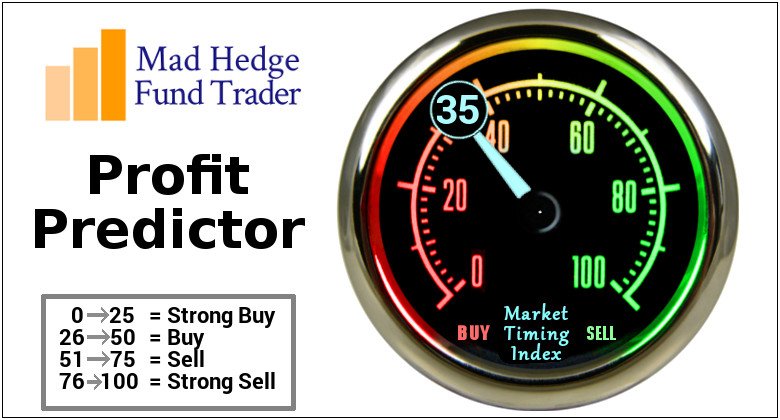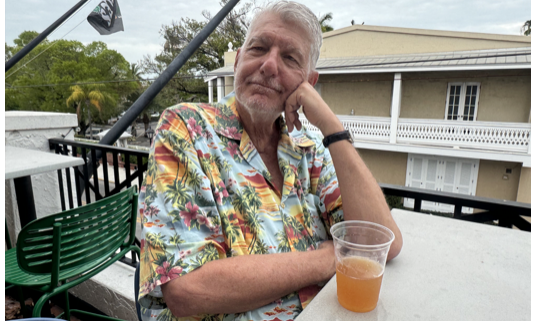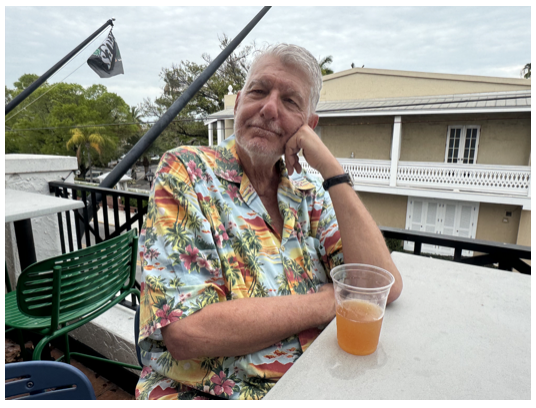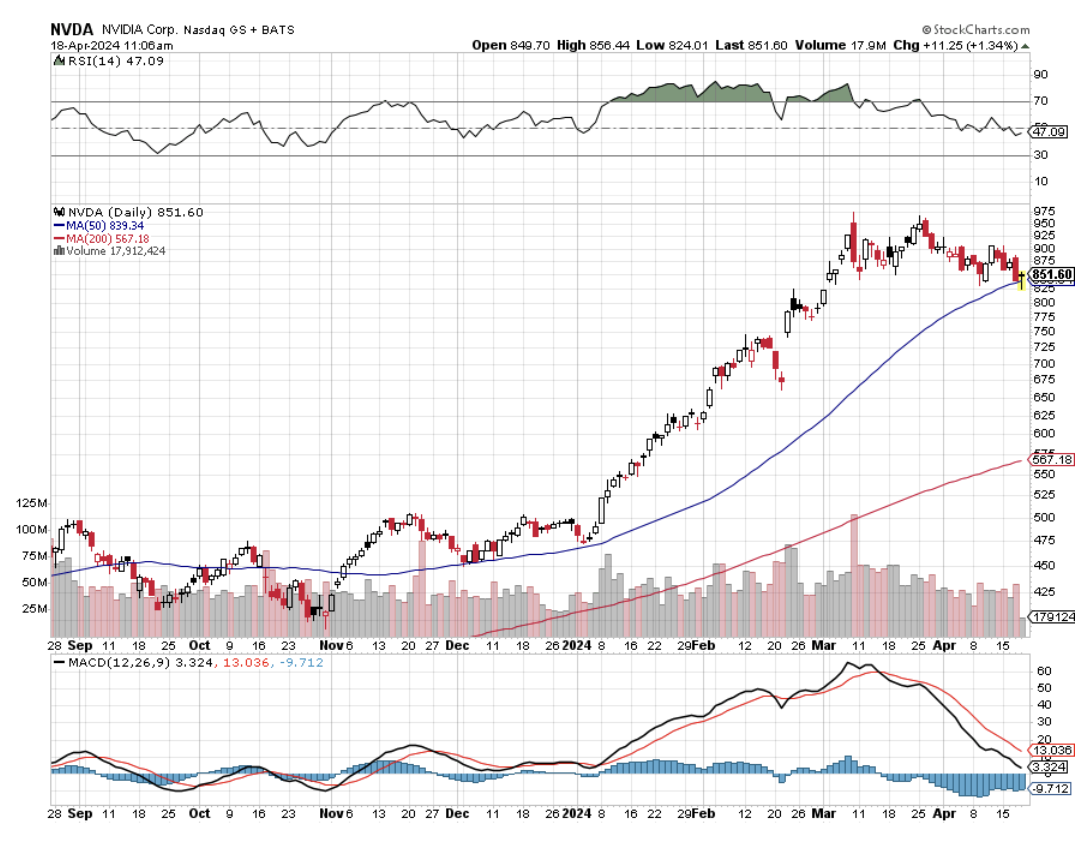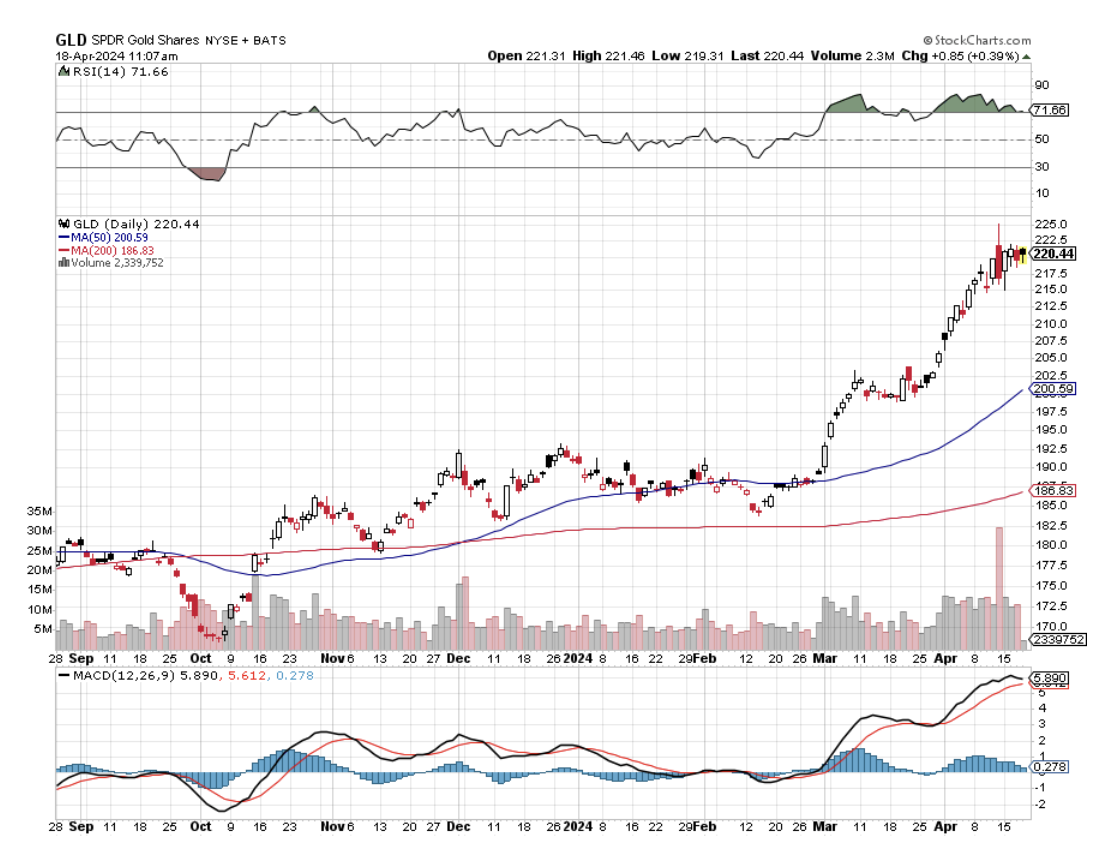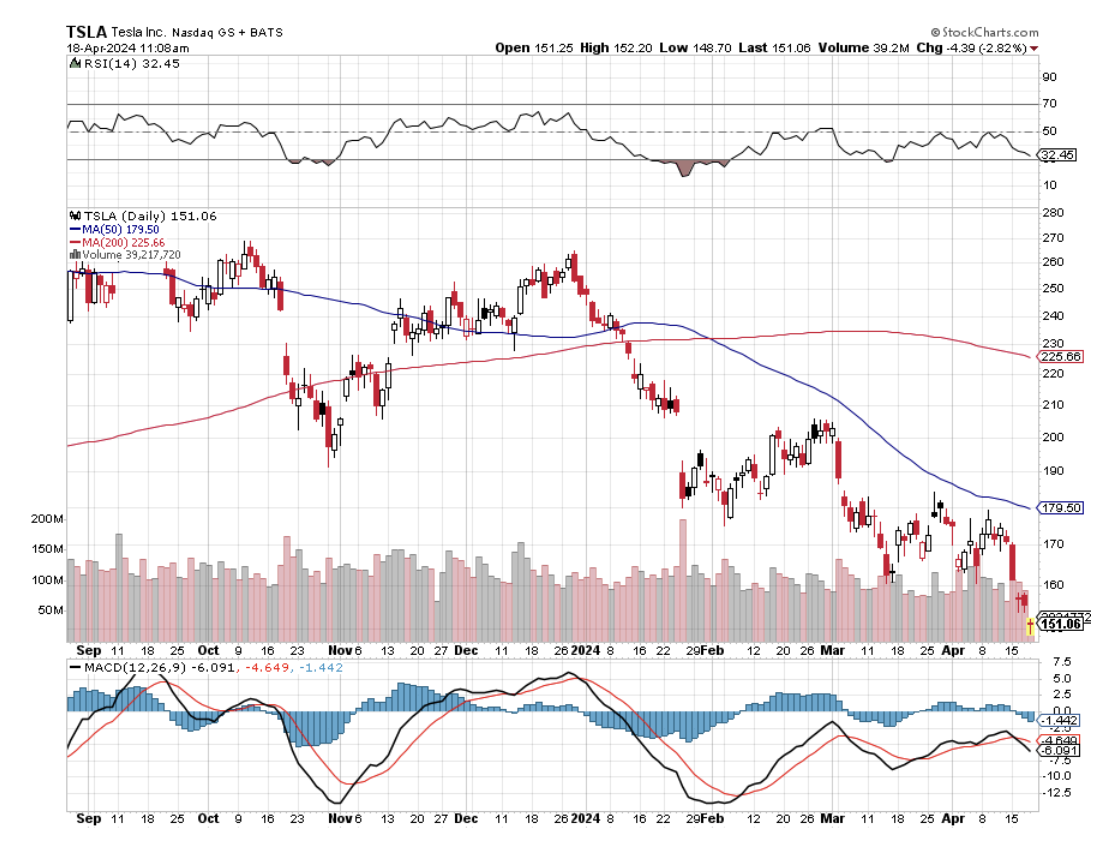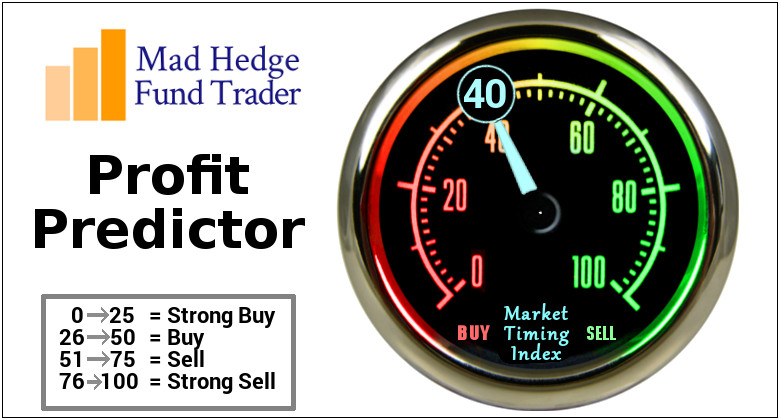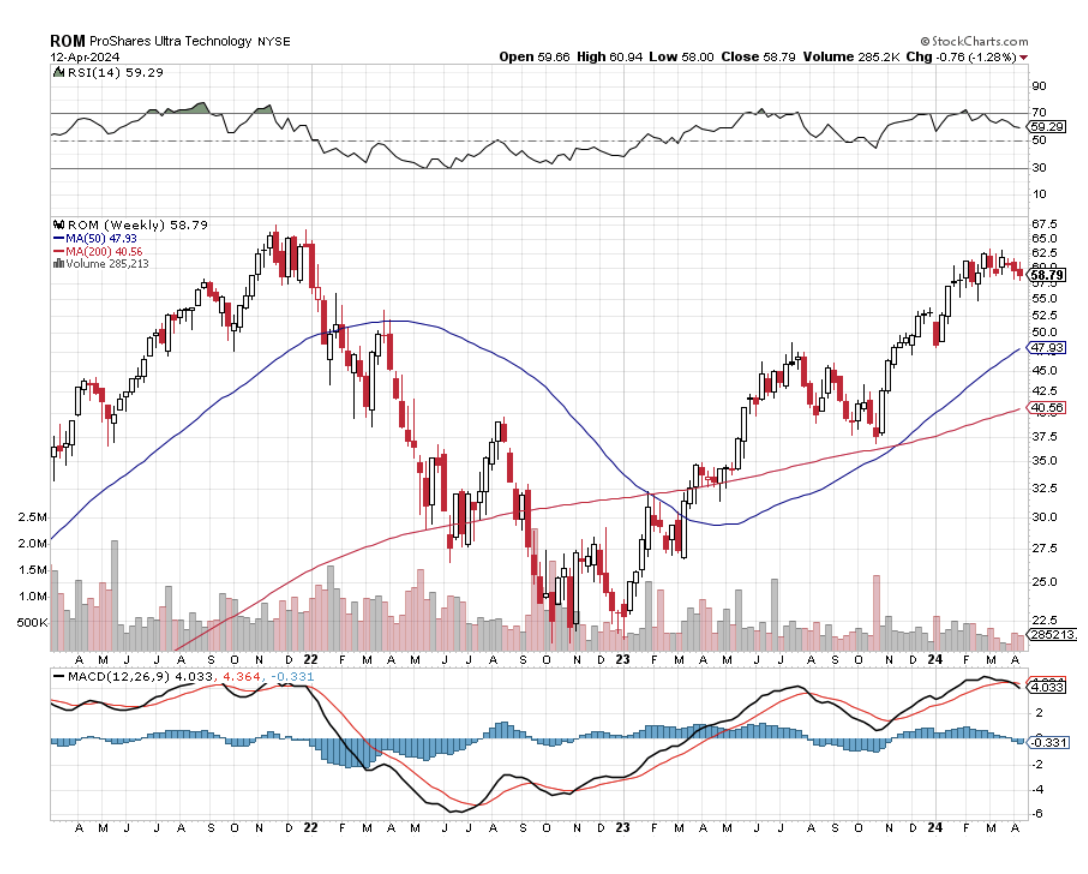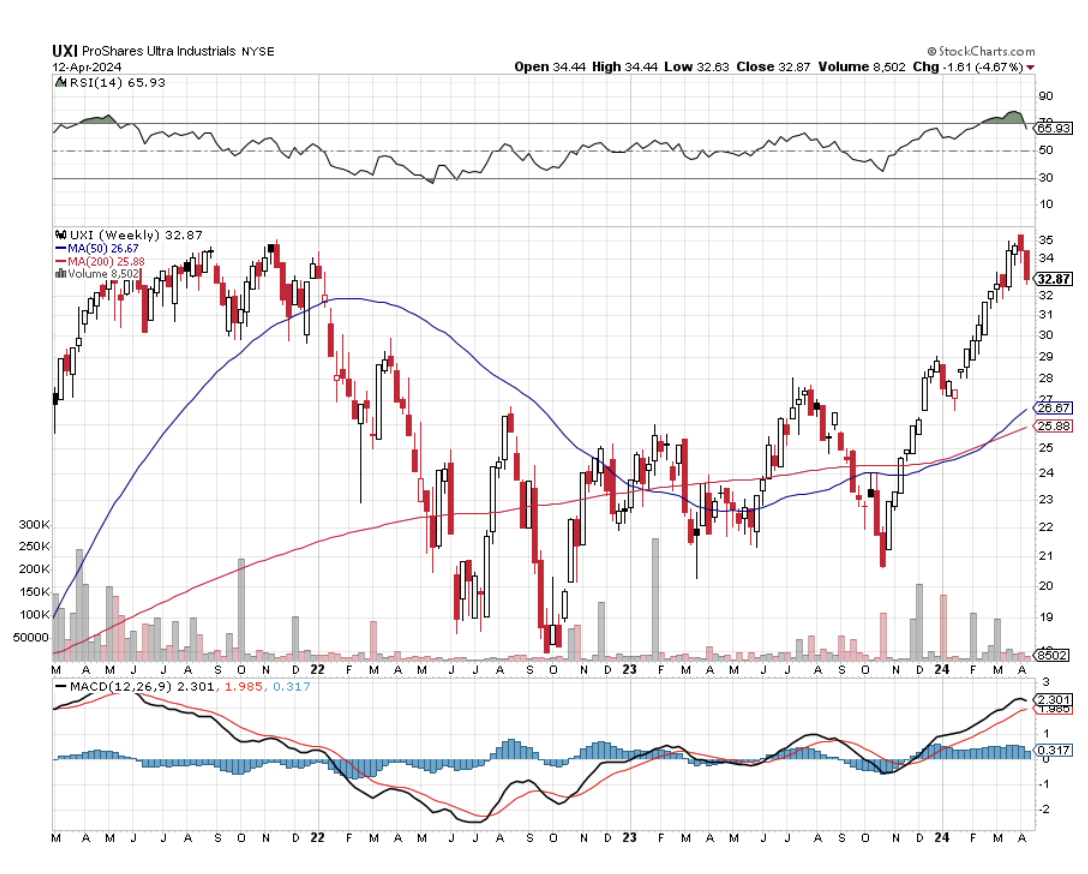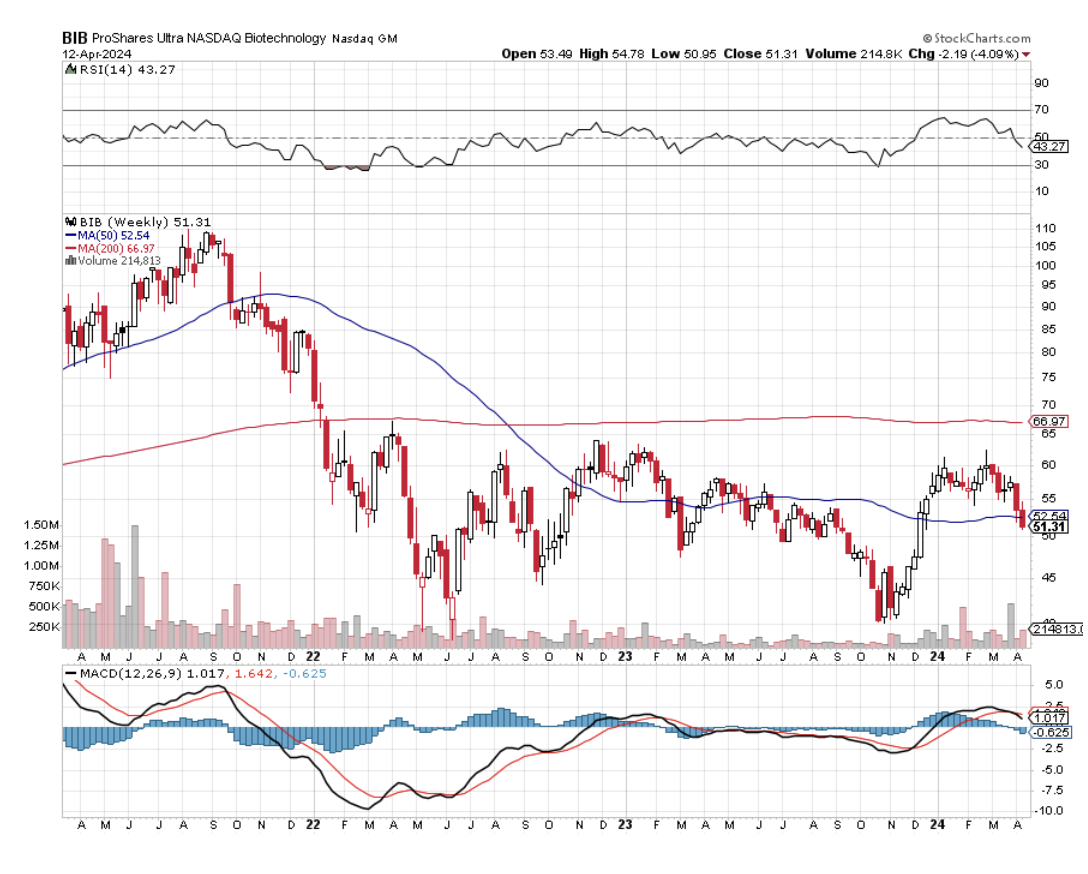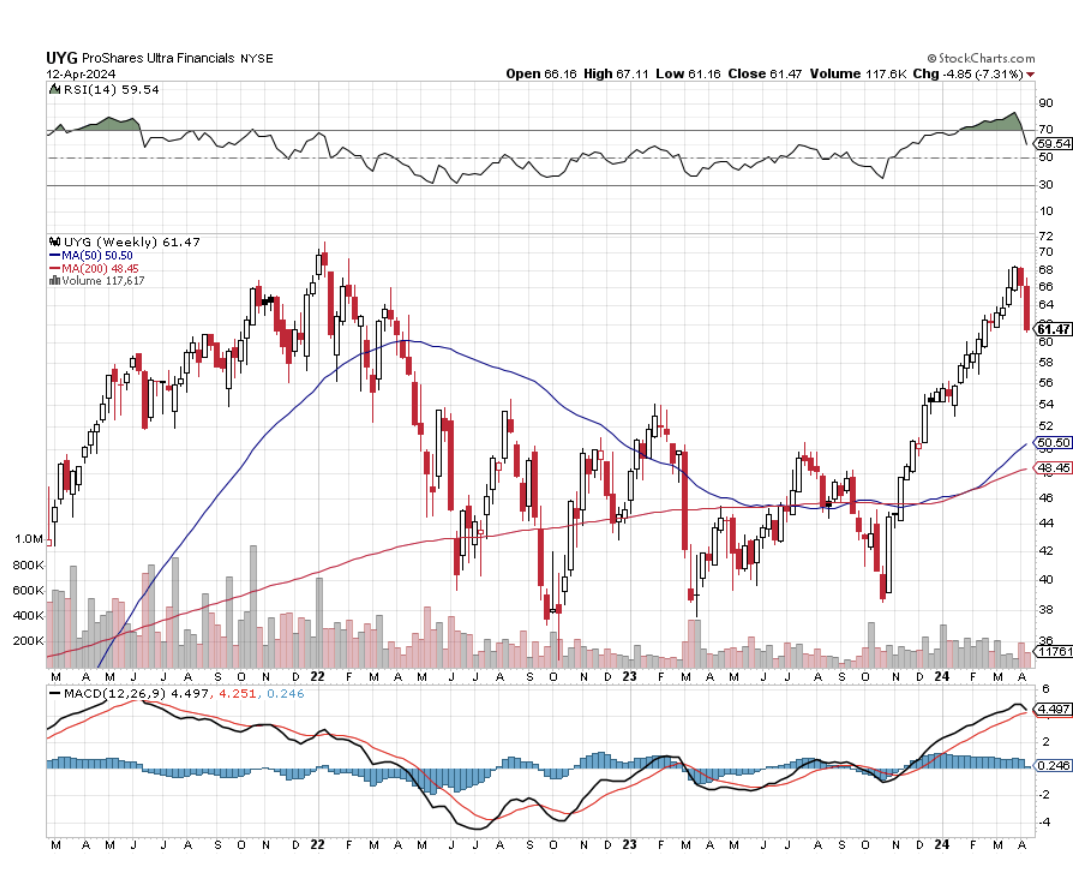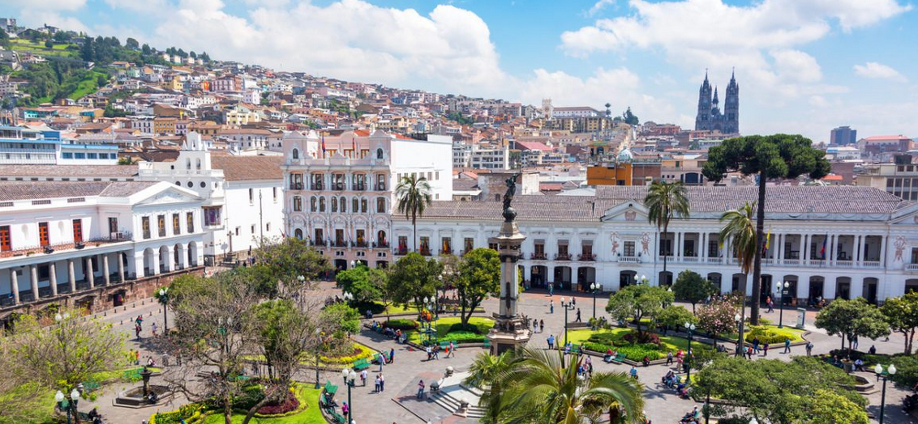“We are one budget deal away from being the hot spot of the world. Europe is in the toilet, China’s growth has fallen down, and the Middle East is going backwards. We have a lot of potential for fracking and innovation. If we can prove our nation is governable, we will be the golden spot in the world,” said David Brooks, a conservative columnist for the New York Times.
Global Market Comments
April 18, 2024
Fiat Lux
Featured Trade:
(APRIL 16 BIWEEKLY STRATEGY WEBINAR Q&A),
(GLD), (GLD), (GE), (GM), (NVDA), (TSLA), (ARKK), (MS), (GS)
Below please find subscribers’ Q&A for the April 16 Mad Hedge Fund Trader Global Strategy Webinar, broadcast from Key West, Florida.
Q: If Elon Musk died, would you sell Tesla (TSLA)?
A: Yes. A lot of Tesla’s success is because Elon Musk alone can push people to do the impossible, only because he’s the largest shareholder and therefore is in complete control of all of the dozen or so Tesla major operations. Certainly, nobody else would be crazy enough to invest in so many businesses at once, like SpaceX, like the storage business, SolarCity, Nueralink, and AI, and get away with it. But then, very few people are willing to work 24 hours/day, 7 days/week either. Musk is also the world’s greatest risk-taker with his own money. So Elon Musk is a large part of the Tesla added value; if you take him away, it just becomes another General Electric (GE) (or worse, General Motors (GM)).
Q: Are geopolitical risks in the Middle East a threat to the stock market?
A: No. Several people commented in my Monday morning letter that I didn’t even mention the Middle East, and that’s because it has no market impact beyond a day. Nobody could care less. All we can do is feel sorry for all the civilians who are dying on both sides. In my lifetime, every geopolitical crisis has been a “BUY” in the stock markets, and in all risk assets. In the old days, it used to take them a month or two to figure it out, now it takes a few hours, so you just get one down day, everybody buys into that low, and markets continue up. Far more impact on the market these days is the inflation rate because that's what the Fed is looking at and they’re the ones who have their hands on the interest rate throttle. And even if inflation does stay where it is now, they’ll still have to eventually cut rates because otherwise the half of the economy that is dependent on interest rates will be destroyed. The other technology half doesn’t really care because they’re all positive cash flow, so they benefit from high interest rates.
Q: How do you select your spread prices?
A: I look at the bid-offer spread in the market, I send you a screenshot of that bid-offer spread, and then I move 5 or 10 cents off the bid side of the market. Normally, if you tighten the spread at the bid side, you will get filled on that order, and if you don’t, just leave it in there, and the second the market trends down you’ll get filled, or if you leave it the next day you’ll get filled. Remember that the second I put out a trade alert, algorithms take it up to the offered side of the market, but algorithms have to go 100% cash by the end of the day and dump all their positions, so if you leave an order in until the end of the day, often you get filled unless there’s been a major market move.
Q: Will gold continue higher?
A: Yes it will. For a start, it isn’t selling off with other risk assets in the recent correction. (GLD) only dropped $10 from an intra-day high of $225, and even though the Fed may not be cutting interest rates today, their next move will be a cut, even if that's in 3, 6, or 9 months. So, people are buying gold for that reason. Also, historically, it’s cheap relative to other asset classes such as stocks and bonds. On top of that, you have China and Russia buying record amounts of gold to bypass the Western financial system. They’ve done that for many years and it’s finally created a big short position on the market. Oh, and they’re not making gold anymore—the amount of gold being mined has been declining now a decade as the costs of mining gold rise.
Q: Why is inflation staying so high?
A: One of the reasons is that there were huge gaps in the supply/demand system due to COVID-19 still being addressed three years after the fact. That created price spikes and all kinds of unexpected consequences. Also, a lot of the government stimulus, or “COVID money,” hasn’t been spent yet; it’s still out there at the contract level and is still being committed. Even if you signed a contract two years ago, it can take two years to get a major construction project started with the planning, design, etc. Rule of thumb in dealing with all governments: everything happens slowly. All over the country, there are construction projects starting using the Federal stimulus money, so that also creates inflation when you have $3 trillion in new spending. That’s what your local traffic jam is all about. Here in Key West, they are rebuilding the Atlantic side waterfront, and that has to cost billions of dollars, far beyond what the locals could afford. But the major component of inflation, which is labor, is flatlining now. We are seeing a lot of one-time-only increases in pay going through, and then there won’t be any after that for a long time. Rising rents are a big problem now.
Q: Can you explain the market timing index?
A: The profit predictor updates itself every time we do a mouse click for all the different algorithms to kick in and generate a new number, and every piece of research we send out has an updated market timing index in it. So, if you get all of our services with Mad Hedge Hot Tips, the Global Trading Dispatch, the Trade Alerts, etc., we’re sending out at least ten updates a day for the market timing index. Suffice it to say, the more services you buy, the more updates you get on the market timing index.
Q: Will (USO) oil sell off on peace in the Middle East?
A: Well actually we’re seeing that today—we’re getting a selloff on the highs after Israel did not launch a tit-for-tat retaliation on the missile attacks from Iran. On the day they do, you will see prices go back up again. But the goal here is to dial back responses. The rule of thumb in defense for the US is: when somebody attacks you, you attack back with twice the force. That way you discourage any further retaliation from the enemy. That certainly is how our nuclear response is designed, and it’s pretty successful because only the US has the ability to execute unlimited increases in military response.
Q: Is Starlink a Tesla company?
A: Starlink is owned by SpaceX, which is an independent company owned by Elon Musk and several venture capitalists, but of course, Elon Musk is the largest shareholder. Space X is worth about $180 billion these days with several large government contracts. It’s why Elon Musk became a US citizen (foreigners are not allowed to launch our top-secret military satellites).
Q: How far-in-the-money do you go in your spread purchases?
A: It’s totally driven by the volatility of the individual stock. If you have a boring stock, you only go 5% in the money in order to earn enough money to make it worth it. If you have high volatility stocks like Tesla (TSLA) or Nvidia (NVDA) which both have options implied in the mid-40%s, you can get away with 20% in-the-money and still make a decent profit one month out. As you can tell, I tend to gravitate towards the highest volatility stocks in the market that are liquid.
Q: Will the 10% staff cut at Tesla hurt the stock?
A: Staff cuts mean bigger profits because you’re reducing the overhead by 10%. Staff cuts in almost every other technology company have been positive for the stocks for this reason. So I would say no, and Tesla has bigger problems than staff cuts like the nuclear winter going on in EV sales.
Q: Why won’t Nvidia (NVDA) go down?
A: Well, it’s because it has such a lead against all competitors. And, you know, in any other industry you’d just go hire the staff or buy the division in order to get it to hold in the market—you can’t do that with Nvidia because they’re all rich and have stock options priced at the $1 or $2 level to lock them in for life. The CEO Jensen Huang is now the sixth richest man in the world.
Q: Why have bonds failed to rally with the rest of the market?
A: Because the Fed isn’t cutting interest rates any time soon and bonds are dependent on the level of interest rates, which means they will rise once the Fed does cut.
Q: Should I buy Goldman Sachs Group (GS) on their great earnings report?
A: Yes, trading volumes look good for the rest of the year and that is how brokerage houses make their crust of bread. Buy Morgan Stanley (MS) too. It’s a better quality company with less dependence on trading revenues and more on fee income. After all, they hired me!
Q: Should I buy Cathie Woods’s Ark Innovation ETF (ARKK) fund here?
A: Absolutely not. Highly leveraged funds and the most leveraged stocks are the last thing you buy on market tops. That is a market bottom play, and the last real market bottom we had was in October.
To watch a replay of this webinar with all the charts, bells, whistles, and classic rock music, just log in to www.madhedgefundtrader.com, go to MY ACCOUNT, select your subscription (GLOBAL TRADING DISPATCH, TECHNOLOGY LETTER, or Jacquie's Post), then click on WEBINARS, and all the webinars from the last 12 years are there in all their glory
Good Luck and Stay Healthy,
John Thomas
CEO & Publisher
The Diary of a Mad Hedge Fund Trader
2024 Key West Thinking of the Next Trade Alert
“When you’re running budget deficit of $1.6 trillion and you’re going to cut $38 billion out of it, if you were a bellhop you wouldn’t accept that as a tip,” said my former colleague at Morgan Stanley, Byron Wien of hedge fund giant Black Rock.
Global Market Comments
April 17, 2024
Fiat Lux
Featured Trade:
(THE LAZY MAN’S GUIDE TO TRADING),
(ROM), (UXI), (BIB), (UYG),
(THE NEXT THING FOR THE FED TO BUY IS GOLD)
(GLD), (GOLD), (GDX), (NEM)
I like to start out my day by calling readers on the US East Coast and Europe, asking how they like the service, if are there any ways I can improve the service, and what topics they would their like me to write about.
After all, at 5:00 AM Pacific time, they are the only ones around.
You’d be amazed at how many great ideas I pick up this way, especially when I speak to industry specialists or other hedge fund managers.
Even the 25-year-old day trader operating out of his mother’s garage has been known to educate me about something.
So when I talked with a gentleman for Tennessee the morning, I heard a common complaint.
Naturally, I was reminded of my former girlfriend, Cybil, who owns a mansion on top of the levee in nearby Memphis overlooking the great Mississippi River.
As much as he loved the service, he didn’t have the time or the inclination to execute my market-beating Trade Alerts.
I said “Don’t worry. There is an easier way to do this.”
Only about a quarter of my followers actually execute my Trade Alerts and a lot of them are professionals. The rest rely on my research to correctly guide them in the management of the IRA’s 401k’s, pension funds, or other retirement assets.
There is also another, easier way to use the Trade Alert service. Think of it as a “Trade Alert light.” Do the following.
1) Only focus on the four best of the S&P 500’s 101 sectors. I have listed the ticker symbols below.
2) Wait for the chart technicals to line up. Bullish long-term “Golden crosses” are setting up for several sectors, as with energy and precious metals.
3) Use a macroeconomic tailwind, like the ramp-up from a 2.0% GDP growth rate to 3.4% we are currently seeing.
4) Shoot for a microeconomic sweet spot, companies and sectors that enjoy special attention.
5) Increase risk when the calendar is in your favor, such as during November to May.
6) Use a modest amount of leverage in the lowest-risk bets, but not much. 2:1 will do.
7) Scale in, buying a few shares every day on down days. Don’t hold out for an absolute bottom. You will never get it.
The goal of this exercise is to focus your exposure on a small part of the market with the greatest probability of earning a profit at the best time of the year. This is what grown-up hedge funds do all day long.
Sounds like a plan. Now what do we buy?
(ROM) – ProShares Ultra Technology 2X Fund – Gives you double exposure to what will be the top-performing sector of the market for the next six months, and probably the rest of your life. Click here for details and the largest holdings.
(UXI) – ProShares Ultra Industrial Fund 2X – Is finally rebounding off the back of a dollar that will slow down its ascent once the first interest rate hike is behind us. Onshoring and incredibly cheap valuations are other big tailwinds here. For details and largest holdings, click here.
(BIB) – ProShares Ultra NASDAQ Biotechnology 2X Fund – With technology, this will be the other hyper-growth sector in the stock market for the next 20 years. How much is a cancer cure worth to stock valuations? Oh, about $2 trillion. A basket approach favors this notoriously volatile sector by rotating in new winners to replace losers.
(UYG) – ProShares Ultra Financials 2X Fund – Yes, after six years of false starts, interest rates are finally going up, with a December rate hike by the Fed a certainty. My friend, Janet, is handing out her Christmas presents early this year. This instantly feeds into wider profit margins for financials of every stripe. For details and largest holdings, click here.
Of course, you’ll need to keep reading my letter to confirm that the financial markets are proceeding according to the script. We all know that sectors can rotate rapidly, as they have just done.
You will also have to read the Trade Alerts, as we include a ton of deep research in the Updates.
You can then unload your quasi-trading book with hefty profits in the spring, just when markets are peaking out. “Sell in May and Go Away?” I bet it works better than ever in 2024.
For Those Who Invest at Their Leisure
A huge new buyer may eventually enter the gold market.
That could be a year off, maybe two, or three at the most.
I’ll give you a hint who: your taxes will pay for it.
If true, it could send the price of the barbarous relic soaring above $5,000, or even $50,000 an ounce, a target long led by the tin hat Armageddon crowd.
When I spoke to a senior official at the Federal Reserve the other day, I couldn’t believe what I was hearing.
If the American economy moves into the next recession with interest rates already near zero, the markets will take the yields for all interest-bearing securities well into negative numbers.
At that point, our central bank’s primary tool for stimulating US businesses will become utterly useless, ineffective, and impotent.
What else is in the tool bag?
How about large-scale purchases of Gold (GLD)?
You are probably as shocked as I am with this possibility. But there is a rock-solid logic to the plan. As solid as the vault at Fort Knox.
The idea is to create asset price inflation that will spread to the rest of the economy. It already did this with great success from 2009 to 2014 with quantitative easing, whereby almost every class of debt securities was Hoovered up by the government.
“QE on steroids”, to be implemented only after overnight rates go negative, would involve large-scale purchases of not only gold, but stocks, government bonds, and exchange-traded funds as well.
If you think I’ve been smoking California’s largest cash export (it’s not the sunshine) you would be in error. I should point out that the Japanese government is already pursuing QE to this extent, at least in terms of equity-type investments.
And, as the history buff that I am, I can tell you that it has been done in the US as well, with tremendous results.
If you thought that President Obama had it rough when he came into office in 2009, it was nothing compared to what Franklin Delano Roosevelt inherited.
The country was in its fourth year of the Great Depression. US GDP had cratered by 43%, consumer prices crashed by 24%, the unemployment rate was 25%, and stock prices vaporized by 90%. Mass starvation loomed.
Drastic measures were called for.
FDR issued Executive Order 6102 banning private ownership of gold, ordering them to sell their holding to the US Treasury at a lowly $20.67 an ounce.
He then urged Congress to pass the Gold Reserve Act of 1934, which instantly revalued the government’s holdings at $35.00, an increase of 69.32%. These and other measures caused the value of America’s gold holdings to leap from $4 to $12 billion.
Since the US was still on the gold standard back then, this triggered an instant dollar devaluation of more than 50%. The high gold price sucked in massive amounts of the yellow metal from abroad creating, you guessed it, inflation.
The government then borrowed massively against this artificially created wealth to fund the landscape-altering infrastructure projects of the New Deal.
It worked.
During the following three years, the GDP skyrocketed by 48%, inflation eked out a 2% gain, the unemployment rate dropped to 18%, and stocks jumped by 80%. Happy days were here again.
However, in the 21st-century version of such a gold policy, it is highly unlikely that we would see another gold ownership ban.
Instead, the Fed would most likely move into the physical gold market, sitting on the bid for years, much like it recently did in the Treasury bond market for five years. Gold prices would increase by a multiple of current levels.
It would then borrow against its new gold holdings, plus the 4,176 metric tonnes worth $321.6 billion at today’s market prices already sitting in Fort Knox, to fund a multi-billion dollar infrastructure-spending program.
Yes, this all sounds like a fantasy. However negative interest rates were considered an impossibility only a few years ago.
The Fed’s move on gold would be only one aspect of a multi-faceted package of desperate last-ditch measures to resuscitate the economy at some point in the future. The time to start buying gold is RIGHT NOW!
That’s assuming that the gold is still there. The door to the vault at Fort Knox has not been opened since September 23, 1974.
Persistent urban legends and Internet rumors claim that the vault is empty or filled with fake steel bars painted gold.
That is until Treasury Secretary Steven Mnuchin visited the vault on his way to view the solar eclipse at government expense in August 2017.
He says the gold is still there. But only if you believe Steve Mnuchin. A lot don’t.
We’ll never know for sure. Visitors are not allowed.
The Next Economic Stimulus Program?
“Half the world’s job will be wiped out over the next 30 years, and the middle class will be completely wiped out,” said technology guru Mosh Varde.
Global Market Comments
April 16, 2024
Fiat Lux
Featured Trade:
(MAY 3, 2024 QUITO, ECUADOR STRATEGY LUNCHEON)
(BIDDING FOR THE STARS)
(SPX), (INDU)
(TESTIMONIAL)
Come join me for lunch for my Global Strategy Luncheon, which I will be conducting in Quito Ecuador at 12:00 PM on Friday, May 3, 2024. A three-course lunch is included.
I’ll be giving you my up-to-date view on stocks, bonds, currencies commodities, precious metals, and real estate.
And to keep you in suspense, I’ll be throwing a few surprises out there too. Enough charts, tables, graphs, and statistics will be thrown at you to keep your ears ringing for a week. Tickets are available for $269.
Quito, the capital of Ecuador, is high in South America’s Andes mountains at 8,000 feet and dead on the equator. The Old Town was built by the Conquistadors on the ruins of an Inca city. It has since become a key stopover for illegal immigrants from China. Those with heart conditions should not attend.
I’ll be arriving early and leaving late in case anyone wants to have a one-on-one discussion, or just sit around and chew the fat about the financial markets.
The lunch will be held at an exclusive hotel in Quito’s Old Town, the details of which will be emailed to you.
I look forward to meeting you, and thank you for supporting my research.
To purchase tickets for this luncheon, please click here.
Legal Disclaimer
There is a very high degree of risk involved in trading. Past results are not indicative of future returns. MadHedgeFundTrader.com and all individuals affiliated with this site assume no responsibilities for your trading and investment results. The indicators, strategies, columns, articles and all other features are for educational purposes only and should not be construed as investment advice. Information for futures trading observations are obtained from sources believed to be reliable, but we do not warrant its completeness or accuracy, or warrant any results from the use of the information. Your use of the trading observations is entirely at your own risk and it is your sole responsibility to evaluate the accuracy, completeness and usefulness of the information. You must assess the risk of any trade with your broker and make your own independent decisions regarding any securities mentioned herein. Affiliates of MadHedgeFundTrader.com may have a position or effect transactions in the securities described herein (or options thereon) and/or otherwise employ trading strategies that may be consistent or inconsistent with the provided strategies.


